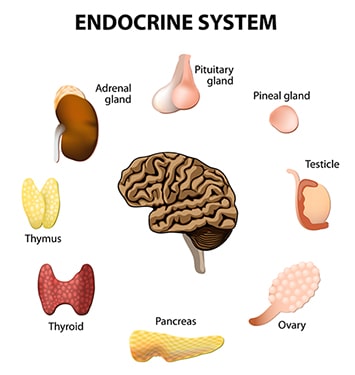
The hormonal roles in neurologic and emotional health were described earlier, but mold’s disruption of health through hormonal imbalance extends further. Cortisol, thyroid, and reproductive hormones each contribute to mold toxicity’s impact on health. Some brain hormones are directly impacted by mold and add to the symptoms.
For example, the adrenal glands make several hormones, including cortisol. The adrenal hormones are managed by hormones from our brain and influenced by the other hormonal systems. It functions like a spider web. Mold toxins may upregulate or downregulate cortisol production. With upregulation, patients may feel wired and tired, experience insomnia, or heal slowly from simple wounds. With downregulation, patients may experience so-called “ fatigue”. They spend their days tired and foggy.
Medical science the thyroid as the primary gas pedal for metabolism. Too much or too little impacts our health negatively. Due to its far-reaching impact, our bodies use a sensitive monitoring system to keep the speed just right. When mold toxicity and its resulting effects enter the picture, the whole system from top to bottom goes off track. Autoimmunity triggered by a dysfunctional immune system may attack the thyroid, decreasing productivity of the key hormone. The gland itself may slow down production due to nutrient deficiency or direct toxicity. Even when hormone is produced adequately, processes in the other body tissues, may deactivate the T4 form of hormone into an inactive reverse T3 instead of fully active T3. Regardless of whether one or multiple of these mechanisms occur, the individual slows down.
Both males and females depend on the same reproductive hormones for both well-being and prevention of future illness. In women, mold toxicity may lead to imbalances between estrogen and progesterone, or just overall low levels of estrogen, progesterone, DHEA, and testosterone. Infertility, endometriosis, irregular cycles, depressed mood, and Premenstrual Syndrome (PMS) may result. In men, low testosterone deprives them of motivation and libido while elevated estrogen may augment female features with weight gain and breast enlargement.
Within the nervous system, several hormones function to maintain metabolic and functional balance. Some signal within the brain. Some send signals to downstream organs like the ones mentioned above. Mold toxins may raise or lower some of these chemical messengers. Mold may increase or decrease a-diuretic hormone (Vasopressin) affecting the balance of water and electrolytes in the body. stimulating hormone, as a high-level influencer of other hormonal process, may be greatly suppressed. Vasoactive intestinal (VIP) and Vascular Endothelial Growth Factor (VEGF) also get pushed out of alignment causing various symptoms. The brain has many hormonal functions potentially affected by mold.
All in all, hormonal abnormalities cap off the major systems affected by mold toxins along with the immune, neurologic, and gastrointestinal systems. Each have direct effects from mold toxins and secondary effects through the other systems. Together they produce a spider web of interconnected symptoms leaving the mold toxic individual with chaotic body functioning.
